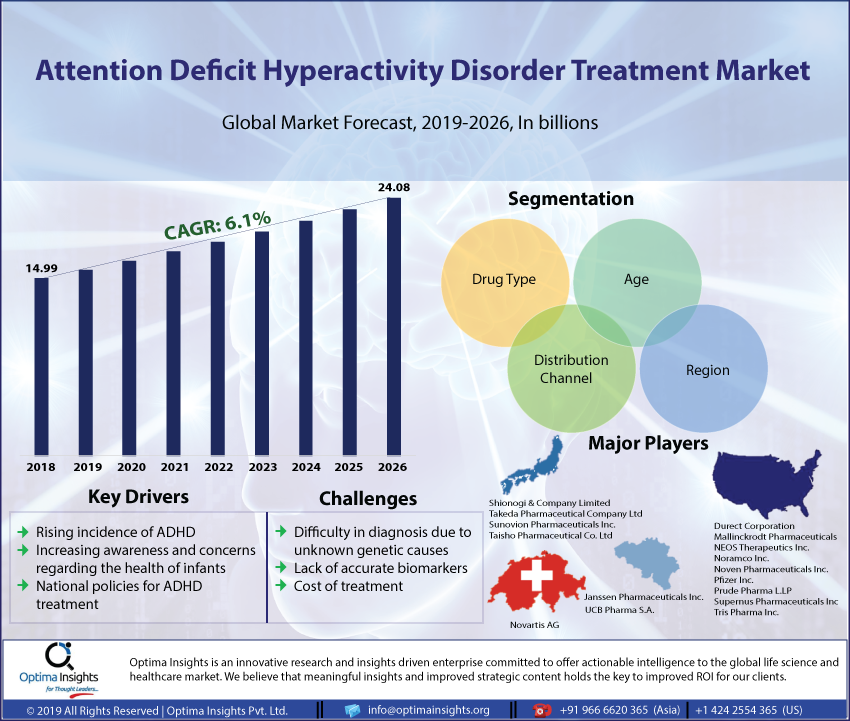Upload your press release
ADHD Treatment Market is Estimated to Reach $24 bn by 2026

The Attention Deficit Hyperactivity Disorder (ADHD) Treatment Market was valued at around US$15 billion at the end of 2018. The revenue is said to engross over US$24 billion by 2026, with a CAGR of 6.1%.
ADHD, classified under the diagnostic criteria DSM-5 by the American Psychiatric Association (APA), characterized by patterns of hyperactivity, inattentions, and impulsivity. The worldwide prevalence of ADHD in children was around 2.3% and 2.8% among adults, in 2018. The reported cases of ADHD in the US alone was around 8.1% in children and 5.2% among adults, in 2017, followed by the European Union nations. With around 68 therapeutic options in active development, product launches and more investment in research and development is set to contribute to the market growth through the forecast period 2019-2026.
Continuous rise in the adult ADHD population with many yet to be diagnosed and the policies drafted at the national level are set to drive the market a CAGR of 6.1% throughout the forecast period. For example, the US government conducts national-level surveys assess ADHD population with the help of the Centre for Diseases Control (CDC) which also assesses the ADHD treatment medications covered by state-sponsored insurance or through Medicaid. In 2016, The US government allocated funds of more than US$50 million to address the treatment requirements of individuals with psychological disorders. Similarly, the National Health Services (NHS), UK allocated US$1.2 billion owing to set-up a five-year plan for aiding patients suffering from mental illnesses.
During recent times, increasing awareness of mental illness is on the rise among the global population with more focus on infants and adolescent population. Parents are ready to go the extra mile to groom their children and provide comfort to raise their children without any psychological problems. This is set to boost the market growth during the forecast period from 2019 to 2026.
However, lack of accurate biomarkers for diagnosing ADHD and unknown genetic causes are still grey areas which have to be addressed. Due to this, the cost of diagnosis is also on the higher side. Besides, the cost of treatment is also likely to hamper the market growth. With more investment contribution towards R&D for developing towards improved and accurate diagnostic methodologies should drive the market during the upcoming years.
The ADHD Treatment Market Outlook 2019-2026, from Optima Insights, will offer a thorough insight on the market growth till the forecast year 2026 based on the market segmentation (Drug Class, Age, Distribution Channel, and Region). The report comprises comprehensive profiling of companies involved in drug development, products of ADHD and pipeline information (inclusive of clinical trial data).
The drug class which is used for ADHD can be classified as Stimulants and Non-stimulants. Stimulants include Lisdexamfetamine dimesylate, Dexmethylphenidate, Dextroamphetamine, Methylphenidate, and Amphetamine. While the non-stimulant types are Clonidine, Bupropion, Atomoxetine, and Guanfacine.
Stimulant drugs dominated the market share in the year 2018. The stimulant drugs always have an upper hand over the non-stimulant drugs attributing to more efficacy. For example, Shire's Lisdexamfetamine ruled the ADHD drug sales in the year 2013 and had also demonstrated to be a gold standard comparable to the other drug lines. Owing to its efficacy, the prescription of stimulant drugs for treating ADHD is increasing. In the year 2018 alone, the usage of the stimulant drug among young ADHD patients was more than 1.56 million, while the adult ADHD individuals taking stimulant drugs were more than 4 million. Recently, the FDA approved Adhansia XR, a high dose (60mg) drug of Purdue Pharma for treating ADHD in children of around 6 years. With more clinical trials underway and govt. support for the usage of stimulant drugs is driving the stimulant ADHD drug market.
However, the lack of evidence on long-term usage of stimulant drugs for ADHD treatment is still debatable. Whereas, non-stimulants are growing in popularity among the US & European populace due to its long-lasting effect and considerably low-risk element. Also, the investments to boost the non-stimulant drug therapies are increasing which is said to drive the drug market in equivalence to the stimulant drug therapies.
The awareness of ADHD is accompanying with frequent clinical visits and physician consults increasing prescription drugs where retails pharmaceutical outlets play a pivotal role and is driving the segment over hospitals segment. This is due to the fact, that hospital inpatient is less owing to lengthy treatment regimens. Thus, making the patients rely on the pharmacies.
Especially, in the US, the amount of prescriptions is more and is increasing every year. Also, the number of ADHD patients in the US are high in number contributing to the North American regional market growth. The North American region is also experiencing the rise of new market entrants because of more investment in R&D and focus on developing therapies that could contribute to improving the lifestyle of the ADHD patient. Following North America, European Market is also said to contribute to the market share. Both North America and US medical coverage policies also contribute to the market share when compared to the other regions such as APAC and LAMEA, which are considered emerging markets with awareness yet to b
More Info: https://www.optimainsights.org
Copyright ©2024. All Rights ReservedDesign, CMS, Hosting & Web Development :: ePublishing